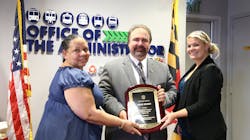MTA Wins Gold Safety Award from APTA
The Maryland Transit Administration (MTA) has received national recognition as the Gold Award for Safety winner from the American Public Transportation Association (APTA) for its Safety Rules and Compliance Program. The award was announced at APTA’s annual Rail Safety & Security Excellence Awards, which honors rail transit agencies in North America for their excellence in safety and security programs and operations. The award was officially announced on June 23 at the 2015 APTA Rail Conference in Salt Lake City, Utah.
MTA’s Safety Rules and Compliance Program (SRCP) was designed to keep customers and employees safe, and to ensure the safety of MTA equipment by implementing shared responsibilities across the Agency’s operating and support departments. Managers are held accountable for the program’s success through the use of custom-designed software that provides feedback and analytics to track performance and trends.
MTA Administrator Paul Comfort noted that the award “shows MTA’s commitment to safe, efficient and reliable transit services across Maryland with world-class customer service. The first word, and most important component, of MTA’s commitment is ‘safe.’ The uniquely collaborative focus of the SCRP means that our riders have an extra measure of certainty that MTA has a system of checks and balances in place to ensure their safety. The bottom line is that MTA is working as a cohesive unit to make safety our number one priority.”
Bernadette Bridges, director of the MTA office of safety, quality assurance and risk management, said, “With all departments working together, including safety, training, operations, field supervision and others, MTA has seen success with the SRCP since it was launched in 2012. After three years of producing positive results and good data, we won national recognition and hope the SRCP will be adapted for use by other transit operators across the country. And that doesn’t mean we will rest on our accomplishments. We are constantly monitoring the program to see where improvements can be made.”
